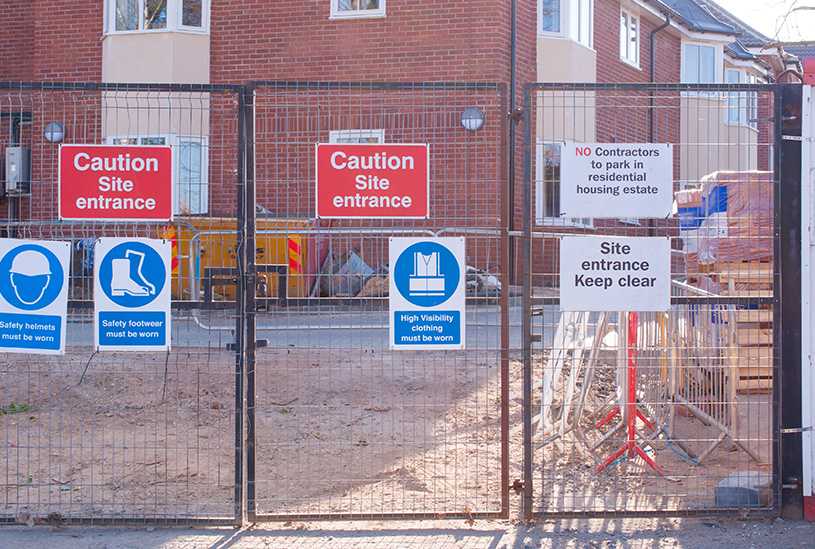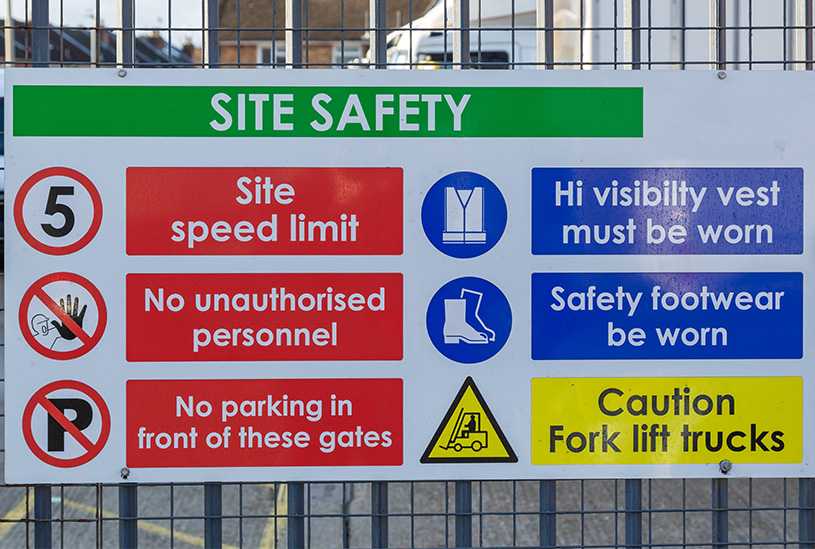Health and safety signs: a guide for businesses
3-minute read

Whether you run your business from an office or a building site, your employees will face a range of risks and hazards each day.
Health and safety signs can help you to reduce risks and give workers vital information about their surroundings.
Read on to find out the common health and safety signs for businesses, plus whether they’re a legal requirement.
Why are health and safety signs important?
Safety signs are bold to attract attention and follow a universal format (explained below) so that people know what to look for. They can communicate risks and hazards quickly by using well-known images and limited words.
As a result, health and safety signage can help to keep your employees safe by alerting them to danger, giving them necessary direction, and showing them where things are in the event of an emergency.
It’s an employer’s legal obligation to use a range of safety signs across their business. All business premises will need signs for emergency exits and fire safety, but it’s likely you’ll need to use extra signs to point out risks that are unique to the work you do.
Health and safety signs and meanings
Most safety and hazard signs are self-explanatory for employees, although some businesses will need to display more complex signs.
Below we explain the differences between the five main types of health and safety signs.
Mandatory signs
Mandatory safety signs show employees something that they must do, such as:
- wearing eye or ear protection
- walking a particular route
- wearing a helmet or gloves
The key features of a mandatory sign are:
- a circle with a white outline and blue background
- an image showing employees what they must do
Warning signs
A warning sign shows employees that there is a specific hazard or danger, such as:
- explosive material
- a steep drop
- industrial vehicles
The key features of a warning sign are:
- a triangle with a black outline and yellow background
- an image showing what employees need to be careful of
Prohibition signs
A prohibition sign tells employees not to do things that could increase or cause danger, such as:
- smoking or using a naked flame
- touching something dangerous
- accessing somewhere as a pedestrian or with a vehicle
The key features of a prohibition sign are:
- a red circle with a diagonal line through the middle
- a black image showing what’s prohibited
Emergency escape or first aid signs
An emergency escape or first aid sign shows employees where they can exit the premises or find medical help in the event of an emergency.
An emergency escape sign usually has an arrow pointing in the direction of an exit.
Meanwhile, first aid signs could point to:
- a stretcher
- eyewash
- emergency telephone
The key features of an emergency escape or first aid sign are:
- a rectangle or square with a white outline and green background
- a white image showing where to exit or find first aid help
Firefighting signs
Fire safety signs show employees where there’s equipment they can use to help put out a fire, such as:
- a fire extinguisher
- a fire hose
- a ladder
- an emergency telephone
Construction site signage
If you work in construction, it’s likely you’ll need to display a lot of safety site safety signs due to the high number of risks.
Here are some examples of common construction signage used to improve site safety:
- a mandatory sign telling visitors to report to the site office
- a warning sign for electrical risks or incomplete scaffolding
- a prohibition sign restricting access of pedestrians or vehicles
- a first aid sign showing where construction workers can get medical help
What type of construction businesses need health and safety signs?
If you work in one of the following trades, it’s likely that you’ll need a range of health and safety signs when working on a building site:

What are the safety signs and signal regulations?
The Health and Safety (Safety Signs and Signals) Regulations 1996 require employers to display relevant signs in places where there’s a risk or danger that employees need to know about.
Signs can be used to alert employees to a risk that hasn’t been removed or reduced by other methods. For example, if there’s no alternative to using machinery that produces excessive noise, a sign can tell employees to wear ear protection. If a sign won’t reduce the risk of something, employers aren’t obliged to use them.
Employers will need to complete a risk assessment (under the Management of Health and Safety at Work Regulations 1999) to determine when and where to use health and safety signs.
It’s important to note that the regulations cover signs for employees, not visitors such as customers.
Protecting your business – make sure you’re covered
Having the right signs in place is just part of the way you can reduce the risk of accidents for your employees.
Although some risks can be managed with signs, others can be covered by insurance, such as:
- slips, trips, and falls
- property damage
- compensation payments and legal costs
The combination of compliant signage and a comprehensive business insurance policy can give you peace of mind that you’re protected should the worst happen.
This article is intended as a guide. Always speak to a health and safety professional if you’re not sure of anything.
Useful guides for employers
Ready to set up your cover?
As one of the UK's biggest business insurance providers, we specialise in public liability insurance and protect more trades than anybody else. Why not take a look now and build a quick, tailored quote?
Start your quote
Written by
Conor Shilling
Conor Shilling is a Copywriter at Simply Business with over two years’ experience in the insurance industry. A trained journalist, Conor has worked as a professional writer for 10 years. His previous experience includes writing for several leading online property trade publications. Conor specialises in the buy-to-let market, landlords, and small business finance.
We create this content for general information purposes and it should not be taken as advice. Always take professional advice. Read our full disclaimer
Keep up to date with Simply Business. Subscribe to our monthly newsletter and follow us on social media.
Subscribe to our newsletterInsurance
Public liability insuranceBusiness insuranceProfessional indemnity insuranceEmployers’ liability insuranceLandlord insuranceTradesman insuranceSelf-employed insuranceRestaurant insuranceVan insuranceInsurersAbout
About usOur teamAwardsPress releasesPartners & affiliatesOur charitable workModern Slavery ActSection 172 statementSocial mediaSite mapAddress
6th Floor99 Gresham StreetLondonEC2V 7NG
Northampton 900900 Pavilion DriveNorthamptonNN4 7RG
© Copyright 2024 Simply Business. All Rights Reserved. Simply Business is a trading name of Xbridge Limited which is authorised and regulated by the Financial Conduct Authority (Financial Services Registration No: 313348). Xbridge Limited (No: 3967717) has its registered office at 6th Floor, 99 Gresham Street, London, EC2V 7NG.